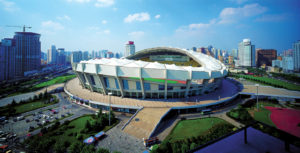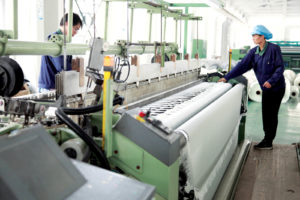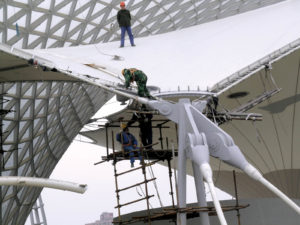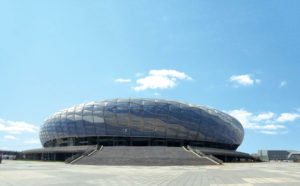
In past decades, with the rapid development of the Chinese economy, noticeable progress has been made for both theoretical research and practical applications of spatial structures in China. New forms of shell and spatial structures have been used in sports facilities, convention and exhibition centers, hangars, manufacturing plants and warehouses. Membrane structures, with the unique advantages of light weight and translucency, have played an important role in the field of building structures in China since 1995. Modern development of spatial structures in China was strongly influenced by the technology from the Western world; the construction of membrane structures in the early stages was mainly dependent on importing. However, as the techniques and materials became more available, the application of membrane structures expanded accordingly.
Beginnings: Learning by building
Modern developments of membrane structures in China started around the last decade of the twentieth century. The construction of the membrane roof for Shanghai Stadium, completed in 1997, had a profound and lasting influence on the development of the industry in China. This modernized multifunctional 80,000-seat stadium represents China’s first major use of structural fabrics. The roof has an elliptical plan (288.4 x 274.4 meters) in a saddle shape with an oval opening, and consists of 32 steel trusses cantilevered as much as 73 meters over the stands. It is covered with a continuous series of umbrella-shaped roof panels held by flying masts using PTFE-coated fiberglass.

In order to provide the most advanced technology, materials and construction, Weidlinger Associates, New York, N.Y., and Birdair Inc., Amherst, N.Y., were invited to provide a design-build service for the fabric roof. Weidlinger did the conceptual and preliminary design and worked with Birdair on the fabric design. The architectural design of the stadium and working drawings of the fabric roof were performed by the Shanghai Institute of Architectural Design and Research. The fabric used was Sheerfill II PTFE fiberglass manufactured by Saint-Gobain Performance Plastics, Merrimack, N.H. All roof panels were fabricated in the U.S. and then shipped to China. The construction of the membrane roof was completed through the joint effort of the Chinese and American contractors within eight weeks.
After the successful completion of Shanghai Stadium, in spite of the relatively high cost compared to conventional structures, membrane structures became the favored choice to cover sports buildings. The Qingdao Estong Stadium was the first large-size stadium designed and constructed in China mainly through its own efforts. The overall size of the stadium is 200 x 180 meters, covered by 60 cone-shaped canopies. The cantilevered roof spanning 40 meters is an integral tensile system composed of membranes, cables and a steel supporting structure. Each unit is covered with Ferrari 1302T fabric. Beijing N&L Fabric Technology Co. was responsible for the design and construction; technical support was provided by Fabric Technology For Structures Pc, Hamburg, N.Y., including the use of computer software for membrane structures. The stadium owner also asked Buro Happold Ltd., London, U.K., to examine the complete design and construction process, as a third party. Through similar projects, a number of Chinese firms started to master the complete process for design and construction of membrane structures.
The leap forward

At the beginning of the twenty-first century, there was a great surge for the industry in China. A large number of enterprises specializing in design, fabrication and erection of membrane structures emerged like bamboo shoots in the springtime; now there are more than 400 such enterprises (most of them small businesses, however). In construction, thousands of membrane structures have been built, ranging from small scenic buildings to large sports facilities. The total area of membrane structures built in China per year is estimated to be more than one million square meters, which should be ranked among the world’s foremost.
Among these applications, roof coverings for large or medium stadium grandstands are found to be the most popular uses. The use of membranes was on an upsurge as Beijing prepared to stage the 2008 Olympic Games. Innovative structural forms and materials were applied to the Beijing National Aquatics Center, nicknamed the Water Cube. The entire building is in a simple form of cube, 176.5 x 176.5 x 30.6 meters. The structural façade and roof are constructed from space frames with air-inflated panels made from ETFE foils. The most recent example of an ETFE panel structure is a stadium in Dalian, Liaoning Province, China.
Another growing market for membrane structures is in exhibition buildings. The forerunner is the International Convention and Exhibition Center in Nanning, the capital of the Guangxi Zhuang Autonomous Region in southern China. A steel cupola in the shape of a rotating hyperboloid shell, with a maximum diameter of 54 meters, is covered with double-layer PTFE fiberglass. The Shanghai EXPO 2010 could also be cited as an international exposition of membrane structures: the most significant is the integral pretensioned membrane roof for EXPO Boulevard, which extended to 840 meters long. Different kinds of fabric, old and new, are employed for various types of roof coverings, exterior claddings and interior walls. A new trend shows that fabric can also clad a building vertically. Meshed fabric is used as cladding for the German Pavilion in Shanghai EXPO. It is also used to clad the stadia in Huizhou and Panjing with extraordinary colors and light.
Material technologies

68 cantilevered radial trusses and
6 annular trusses, covered with air-inflated Texlon® ETFE panels. The large size panels, with maximum area around 51 square meters, allow reduction in the supporting steelwork. Photo: Beijing Vector Foiltec Construction Eng. Co.
Membrane structures can only be used to the extent that their materials can serve. The key issue is to provide an architectural fabric that is functional, durable and economical in use. In the early stages, two main types of architectural fabric have been used: PVC-coated polyester with PVF or PVDF topcoatings, and PTFE-coated fiberglass. For a long time, the fabric used relied on imports. PVC polyester was mainly supplied by Serge Ferrari from France and Mehler Texnologies from Germany, and PTFE fiberglass came from Saint-Gobain North America and Chukoh Chemical Industries in Japan. Several factories in China attempted to produce PVC-coated polyester fabric, but the product was not able to fulfill all the structural and behavioral requirements.
It is not until the recent decade that the production of fabric material has been put on the right track. The Jiangsu VEIK Technology and Materials Co. Ltd., located in Taixing, Jiangsu province, is China’s largest PTFE fiberglass production plant. The company collaborates with DuPont by providing Teflon™ coating, with special permission. There are more than a dozen companies producing PVC polyester fabric, most of them situated in the coastal city of Haining, Zhejiang province, with the exception of Shanghai Shenda Kobond New Materials Co. Ltd. All of these plants are equipped with imported warping, weaving and coating machines, using imported production technology. Fabric production in China is still in its preliminary stages, and the products are seldom used in major projects.
Global opportunities
The advancement of membrane structures in China is benefitting from recent research and technological developments. Computer-aided design (CAD) for different types of membrane structures is commercially available and so popular that nearly all membrane structure projects are using the software for design and construction. For example, a software called “3D3S” was developed with technical assistance from Tongji University in Shanghai; it integrates the functions of pre-processing in automated generation of data, formfinding, nonlinear finite element structural analysis and design and pattern cutting, as well as working drawings.
The promulgation of a series of codes and standards is another important advance. These documents not only serve as a guide for beginners as a gateway to membrane structures, but also put forward the requirements in fabrication and installation—ensuring the quality of design and construction. The earliest one is the Technical Specification for Membrane Structures (CECS 158:2004). For fabric material, there is the professional standard Coated Fabrics for Membrane Structures (FZ/T 64014—2009). More recently, the Specification for Acceptance of Construction Quality of Membrane Structures is under preparation.
Membrane structures are advancing rapidly all over the world with the continuous emergence of sophisticated forms and new materials. Although China has achieved a great deal in the field, there is still a lag behind the international advanced level. With the rapid development of the Chinese economy and the continuous enrichment of cultural life, it’s anticipated that there will be more demand for building various types of membrane structures in China. This will provide growing opportunities for many design, consulting and construction firms both in and outside China.
Examples of cooperative effort are easy to find: Shanghai Taiyo Kogyo Co. Ltd. with Japan; Beijing Vector Foiltec Construction Engineering Co. Ltd. with Germany; Covertex Membranes (Shanghai) Co. Ltd. with Germany; and Guangzhou Canobbio Building Technology Co. Ltd. with Italy. These projects are usually executed through the mutual efforts of Chinese and foreign engineers, which will inevitably bring inspiring ideas and new technology to China. Through the industry and application of membrane structures, the interflow and cooperation between China and the world will further flourish in the future.
Tien T. Lan is a research fellow with the China Academy of Building Research, and the contact person for the China Specialty Committee on Membrane Structures, an affiliate member of IFAI.
Professor Tien T. Lan is a pioneer in promoting the membrane structure industry in China, and among the first to:
• Pursue manufacturers to produce fabrics for architectural use
• Publish articles to explain the advantages of membrane structures
• Conduct graduate studies on membrane structures, with test models
• Sponsor technical specifications for membrane structure design and construction
Tien T. Lan is a research fellow with the China Academy of Building Research (CABR, www.cabr.com.cn), and the contact person for the China Specialty Committee on Membrane Structures, an affiliate member of IFAI.
 TEXTILES.ORG
TEXTILES.ORG


